The structure of the human body is unique. The well-coordinated work of each organ ensures vital activity. Each area consists of a specific set of organs.
Contents
- Internal structure of the person: photo with the inscriptions
- Video: "Human Anatomy. Where is that? "
- Brain is an important human organ
- Video:" The brain, structure and functions "
- Which organs are inside the chest?
- Video: "Chest organs"
- Which organs enter the abdominal cavity?
- How are the pelvic organs located?
- Video: "Human Anatomy. Abdominal organs »
The inner structure of a man: a photo with the inscriptions
A person is the most complex organism on our planet, which is capable of performing several functions simultaneously. All bodies have their duties and work harmoniously: the heart pumps blood, spreading it through the body, the lungs process oxygen into carbon dioxide, and the brain processes thought processes, while others respond to the movement of a person and his life activity.
Anatomy is a science that studies the structure of a person. It distinguishes the external( that can be observed visually) and the inner( hidden from the eyes) structure of a person.
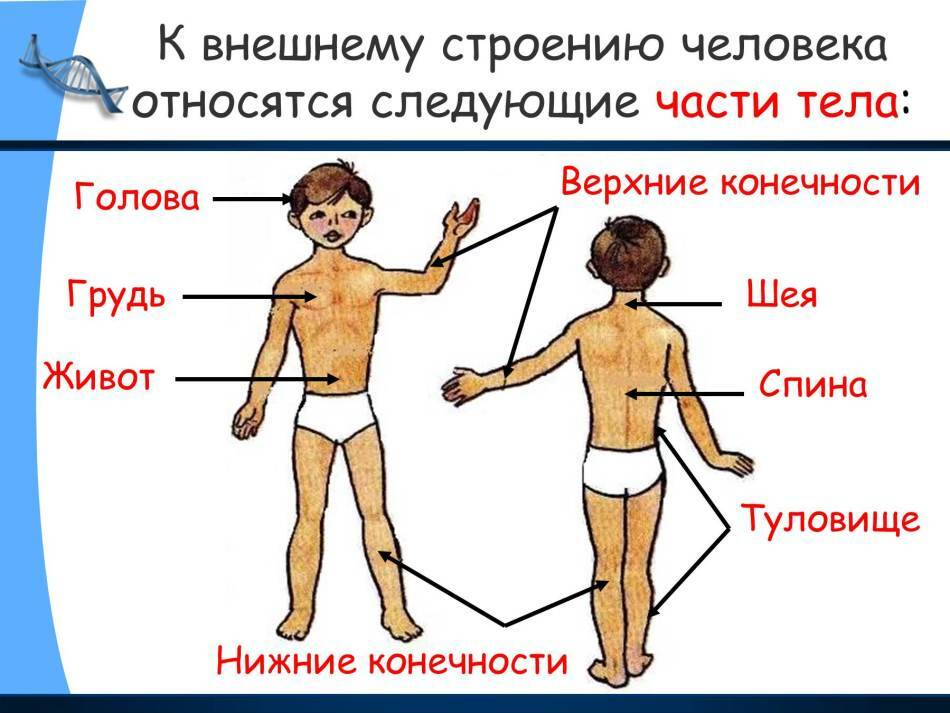 The structure of a person by external features
The structure of a person by external features The external structure of the is the parts of the body that are open to the eyes of a person and can easily be listed:
- head - upper round body
- neck - body part connecting head and trunk
- chest - front part of body
- back- back of the trunk
- trunk - human body
- upper limbs - hands
- lower limbs - legs
The inner structure of the person - consists of a series of internal organs that are located inside the humanka and have their function. The internal structure of a human consists of the main more important organs:
- of the brain
- lungs
- heart
- liver
- stomach
- intestine
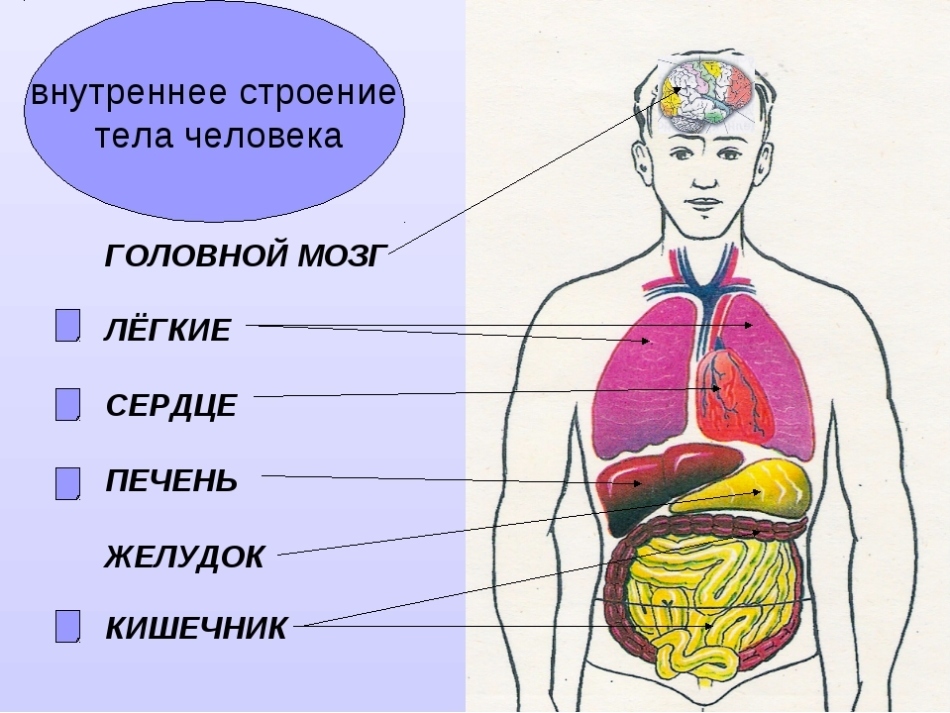 the main internal organs of a person
the main internal organs of a person A more detailed enumeration of the internal structure includes the blood vessels, glands and other vital organs.
 detailed structure of internal human organs
detailed structure of internal human organs You can see that the structure of the human body is similar to the structure of representatives of the animal world. This fact is explained by the fact that, from the theory of evolution, man originated from mammals.
A man has developed along with animals, and not infrequently scientists have noticed his similarity with some representatives of the animal world at the cellular and genetic level.
Cell - is an elementary particle of the human body. The accumulation of cells forms the tissue, itself from which the internal organs of man consist.
All human organs are combined into systems that work in a balanced manner to ensure the full vital activity of the body. The human body consists of such important systems:
- The musculoskeletal system - provides a person with movement and supports the body in the required position. It consists of the skeleton, muscles, ligaments and joints of the
- Digestive system - is the most complex system in the human body, it is responsible for the process of digestion, providing the person with energy for the vital functions of the
- . The respiratory system - consists of the lungs and respiratory tracts,to oxygenate in carbon dioxide, oxygenating blood
- Cardiovascular system - has the most important transport function, providing blood to the entire human body
- NervousI system - regulates all functions of the body, consists of two types of brain: head and spinal, as well as nerve cells and nerve endings
- Endocrine system regulates nervous and biological processes in the body
- Sexual and urinary system - a number of organs that differstructure in men and women. Have important functions: reproductive and excretory
- Covering system - provides protection of internal organs from external environment, represented by skin
Video: "Human Anatomy. Where is that? "
The brain is an important human organ
The brain provides a person with thinking activity, distinguishing it from other living organisms. In fact, it is a mass of nerve tissue. It consists of two large hemispheres, two variolium bridges and a cerebellum.
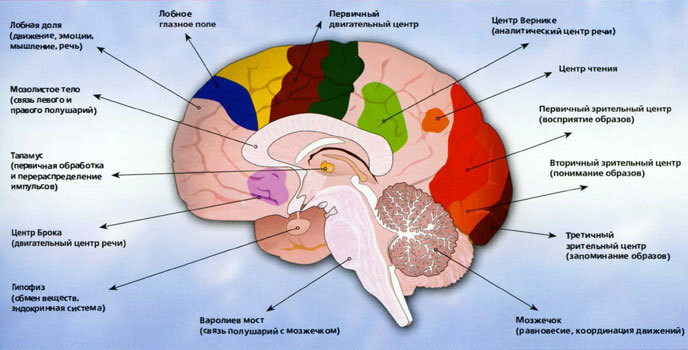 detailed structure of the human brain with descriptions of the
detailed structure of the human brain with descriptions of the - zones. The large hemispheres of the are necessary to control all thought processes and provide the person with conscious control of all movements of the
- . At the rear of the brain is the cerebellum. Thanks to him, man is able to control the balance of the whole body. The cerebellum controls the reflexes of the muscles. Even such an important action as pulling your hand away from the hot surface, so as not to damage the skin - controls the cerebellum
- The Varoliev Bridge lies below the cerebellum at the base of the skull. Its function is very simple - to receive nerve impulses and transmit them
- Another bridge - oblong, is slightly lower and connects to the spinal cord. Its function is to receive and transmit signals from other departments of the
Video: "The brain, structure and functions"
Which organs are located inside the thorax?
In the thoracic cavity several vital organs:
- lungs
- heart
- bronchi
- trachea
- esophagus
- diaphragm
- fork gland
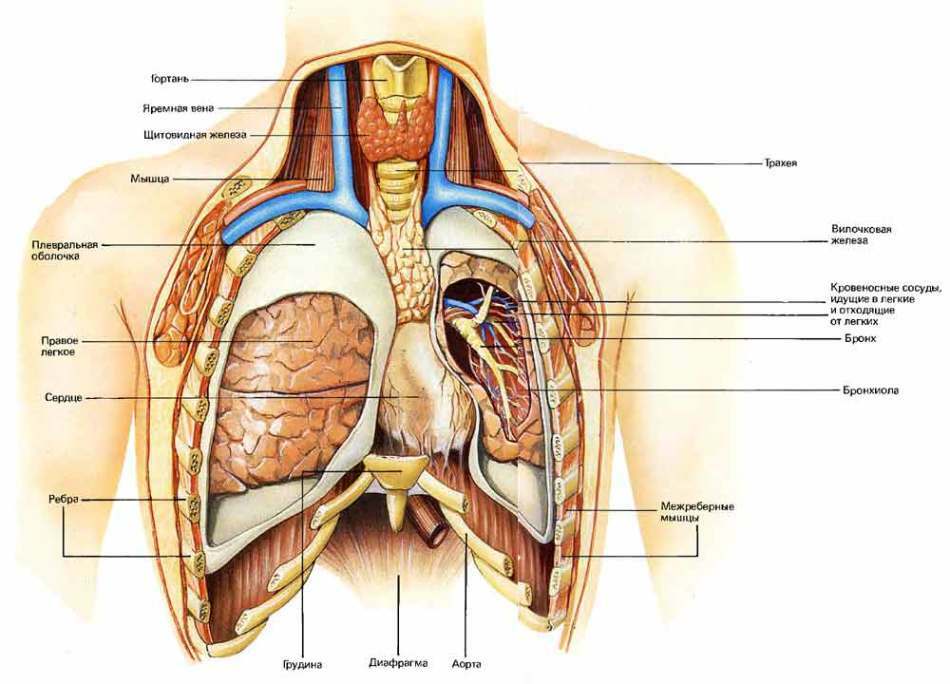 structure of the human thorax organs
structure of the human thorax organs The thorax is a complex structure, mostly filled with light. It contains the most important muscular organ - the heart and large blood vessels. Diaphragm is a broad, flat muscle that separates the thorax from the abdominal cavity.
Heart - between two lungs, in the thorax is this cavity organ-muscle. Its dimensions are not large enough and it does not exceed the size of a fist. The task of the organ is simple but important: to pump blood into the arteries and take venous blood.
The heart is quite interesting - an oblique presentation. The wide part of the organ is directed upwards back to the right, and narrow to the left downwards.
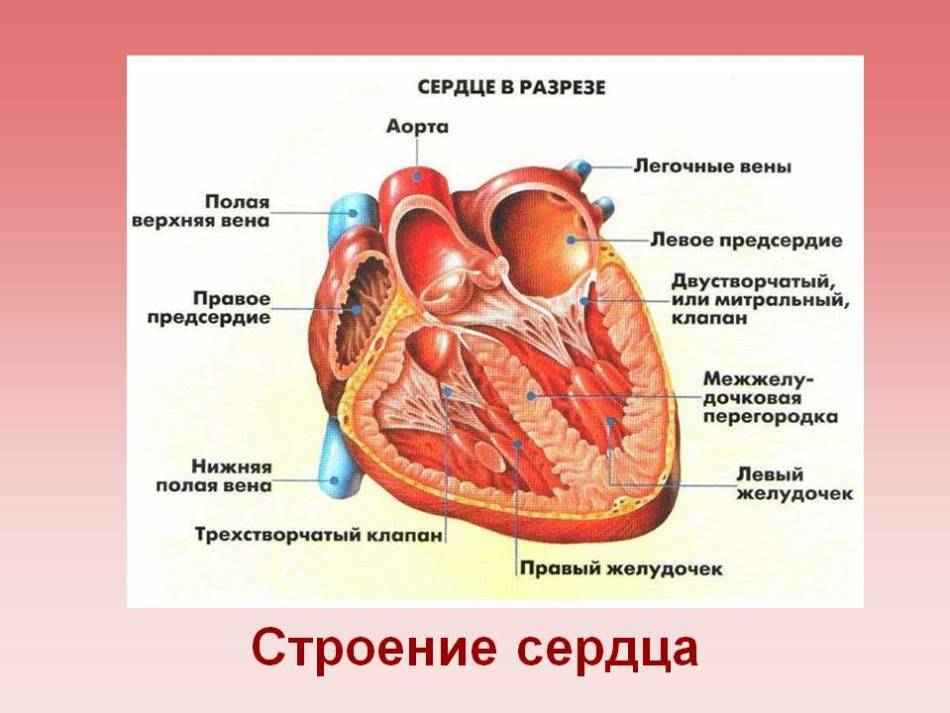 detailed structure of the heart organ
detailed structure of the heart organ - The main vessels emanate from the base of the heart( wide part).The heart should regularly inject and process blood, spreading fresh blood to the entire body.
- Movement of this organ is provided by two halves: the left and right ventricle
- The left ventricle of the heart is larger than the right
- . Pericardium is the tissue covering this muscular organ. The outer part of the pericardium is connected to the blood vessels, the inner part grows to the heart
Lungs - is the most voluminous paired organ in the human body. This organ occupies most of the thorax. These organs are exactly the same, but it should be noted that they have different functions and structure.
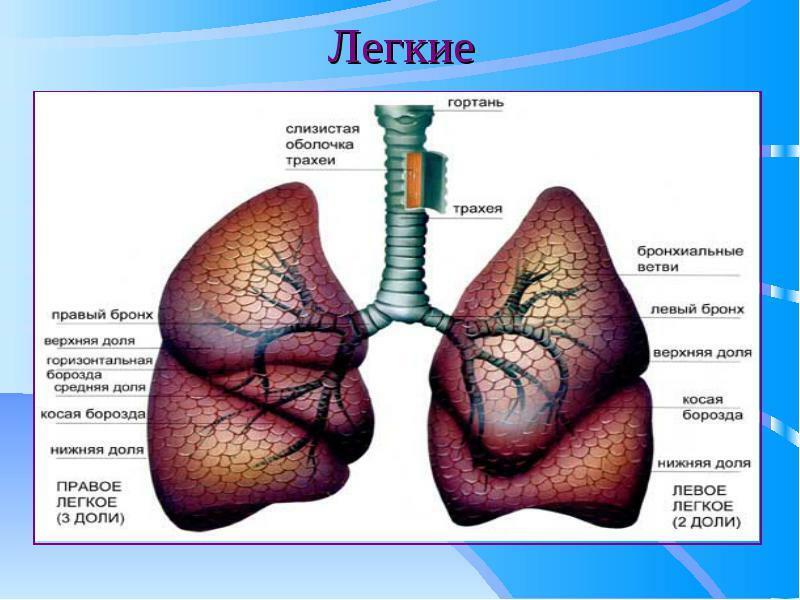 lung structure
lung structure As can be seen in the picture, the right lung has three lobes, in comparison with the left one, which has only two lobes. Likewise, the left lung has a bend in the left side. The task of the lungs is to convert oxygen into carbon dioxide and to saturate the blood with oxygen.
Trachea - occupies a position between the bronchi and the larynx. Trachea are cartilaginous semirings and connective ligaments, as well as muscular tissue on the back wall, covered with mucus. To the bottom, the trachea is divided into two bronchus. These bronchi are sent to the left and right lungs. In fact, bronchus is the most common continuation of the trachea. The lung inside is composed of many branches of the bronchus. Functions of the bronchi:
- airway - carrying air through the lungs
- protective - cleansing function
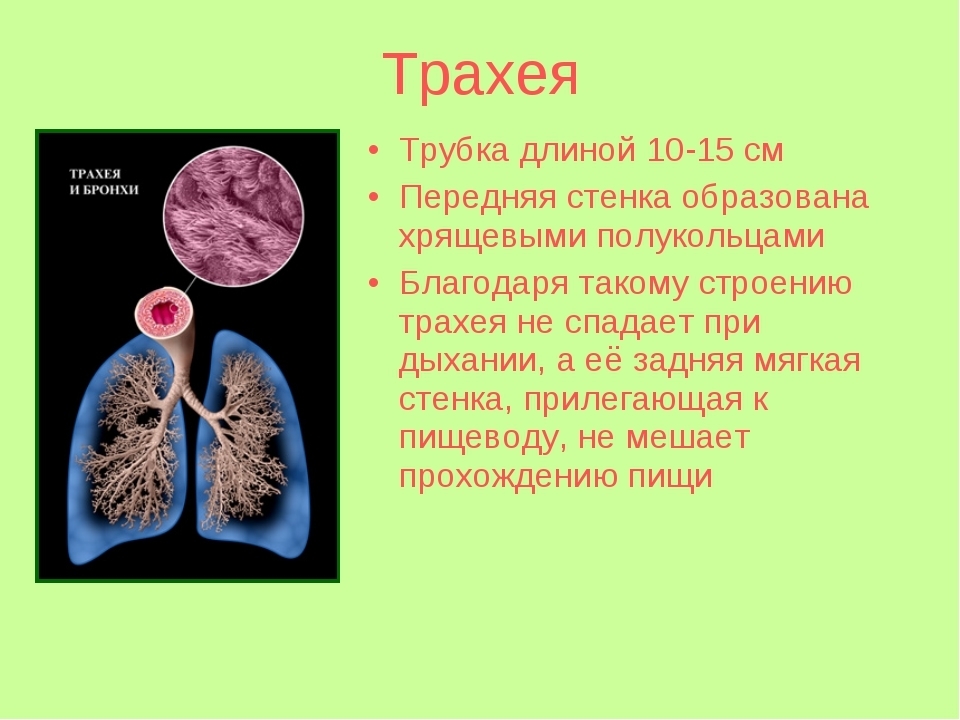 trachea and bronchi, structure
trachea and bronchi, structure Esophagus - is a long organ that originates in the larynx and passes through the diaphragm ( muscular organ), connecting with the stomach. The esophagus has annular muscles, which ensure the movement of food to the stomach.
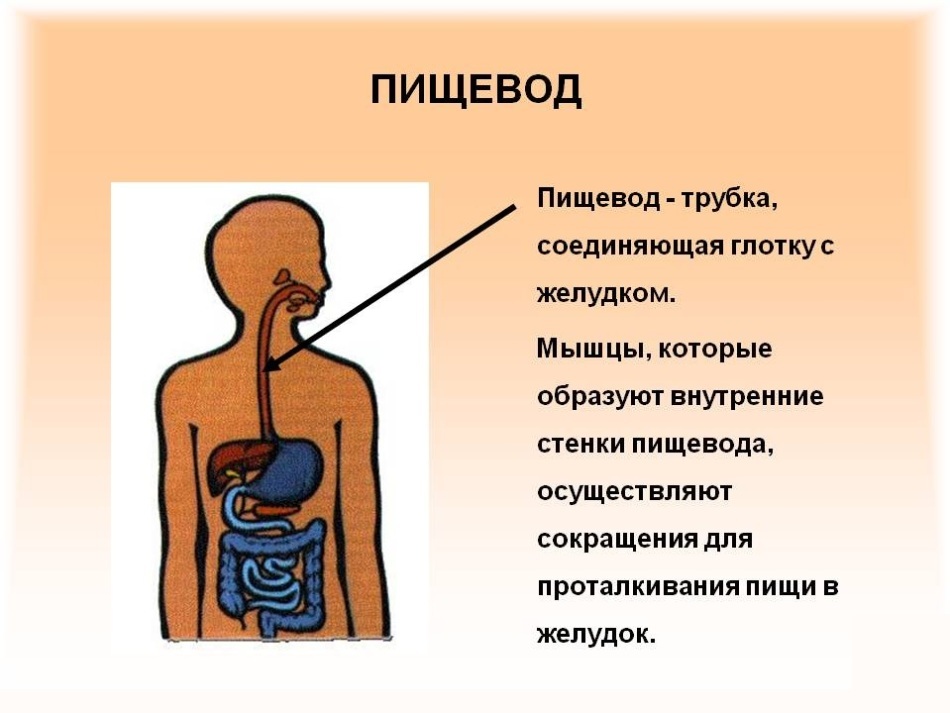 the location of the esophagus in the chest
the location of the esophagus in the chest The fork gland is an iron that has found its place under the sternum. It can be considered part of the human immune system.
 thymus gland
thymus gland Video: "Chest organs"
Which organs enter the abdominal cavity?
The organs of the abdominal cavity are the organs of the digestive tract, as well as the pancreas together with the liver and kidneys. Here are located: the spleen, kidneys, stomach and genitals.the abdominal cavity is covered with the peritoneum.
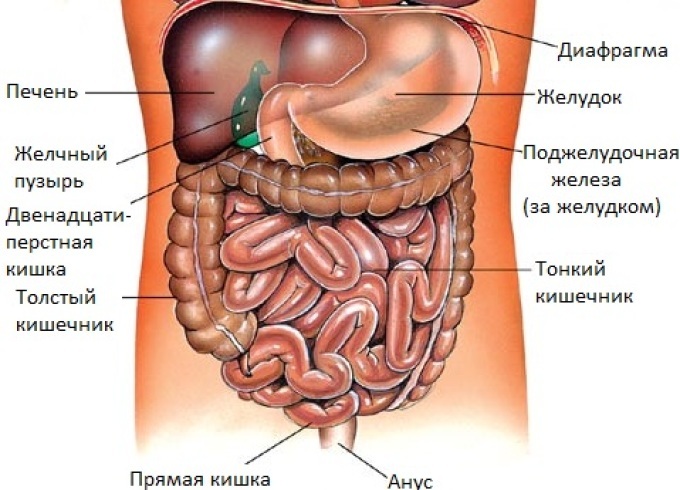 internal organs of the abdominal cavity of a person
internal organs of the abdominal cavity of a person Stomach - is one of the main organs of the digestive system. In fact, it is the continuation of the esophagus, separated by a valve that covers the entrance to the stomach.
Stomach has the shape of a bag. Its walls are capable of producing a special mucus( juice), the enzymes of which will break food.
 stomach structure
stomach structure - Intestine - is the longest and the largest part of the gastrointestinal tract. The intestine begins immediately after the outlet of the stomach. It is built in the form of a loop and ends with an outlet. The intestine has thick, small intestine and straight
- The small intestine( duodenum and iliac) passes into thick, thick
- Intestinal task - to digest and remove food left from the body
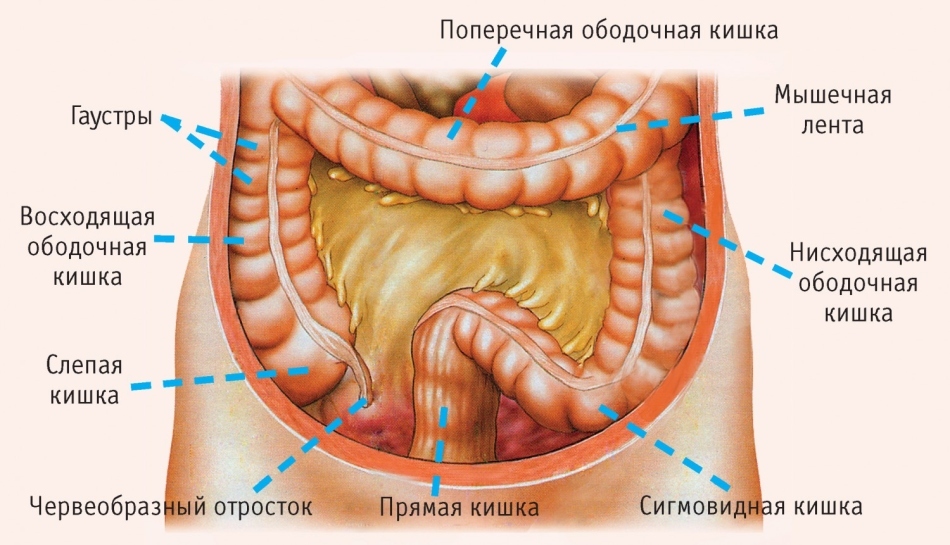 detailed structure of the human intestine
detailed structure of the human intestine Liver - is the largest gland in the human body. It also participates in the process of digestion. Its task is to ensure the metabolism, to participate in the process of blood circulation.
It is located directly under the diaphragm and divided into two parts. Vienna connects the liver with the duodenum. The liver is closely related and functions with the gallbladder.
 Liver structure
Liver structure Kidneys - paired organ located in the lumbar region. They perform an important chemical function - the regulation of homeostasis and urination.
Have buds form beans and are part of the organs of urination. Directly above the kidneys are the adrenal glands.
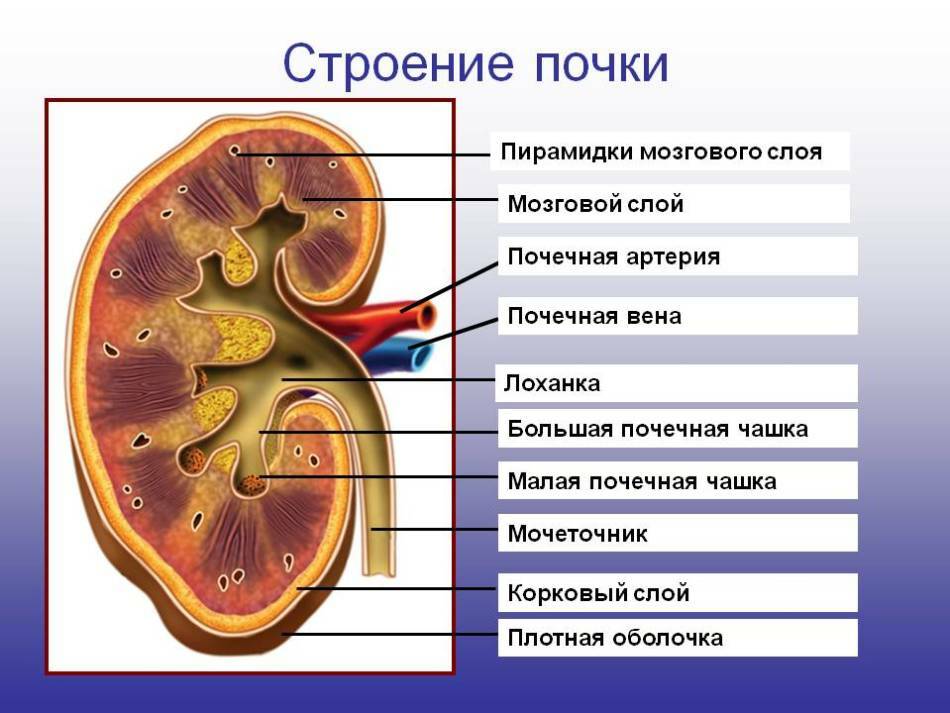 bud structure
bud structure Bladder - is a kind of urine collection bag. It is located just behind the pubic bone in the groin area.
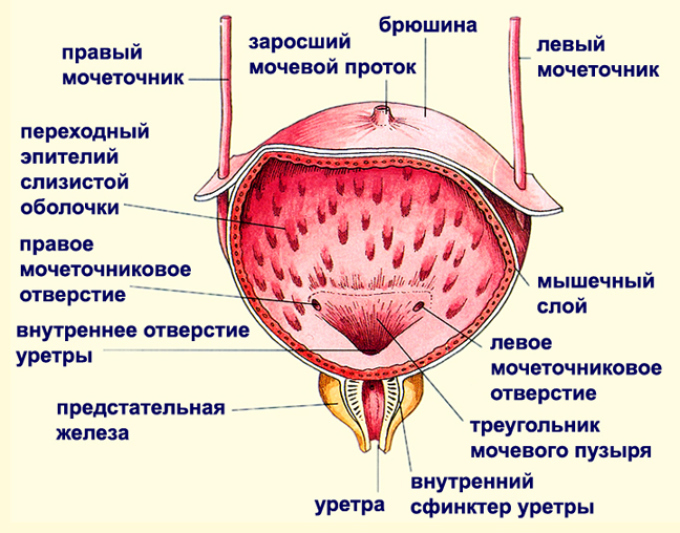 structure of the bladder
structure of the bladder The spleen - is located above the diaphragm. Has a number of important functions:
- aspiration
- body protection
The spleen can vary in size depending on the accumulation of blood.
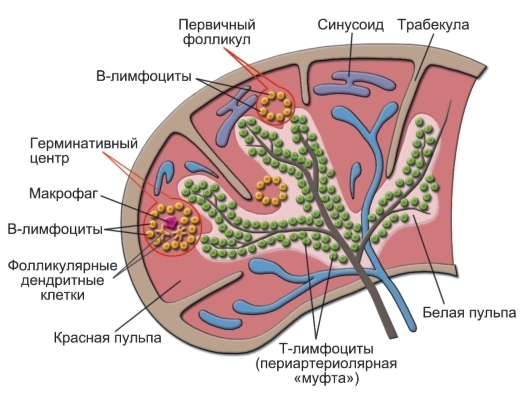 structure of the spleen
structure of the spleen How are the pelvic organs located?
These organs are located in the space bounded by the pelvic bone. It should be noted that the female and male pelvic organs are different.
- Rectum - is a similar organ in both men and women. This is the end of the intestine. Through it products of digestion are deduced. The rectum should be about fifteen centimeters long
- The bladder differs in location, female and male in the cavity. In women, it comes into contact with the walls of the vagina, as well as the uterus, in men it adjoins the seminal vesicles and streams that lead to the seed, as well as to the rectum
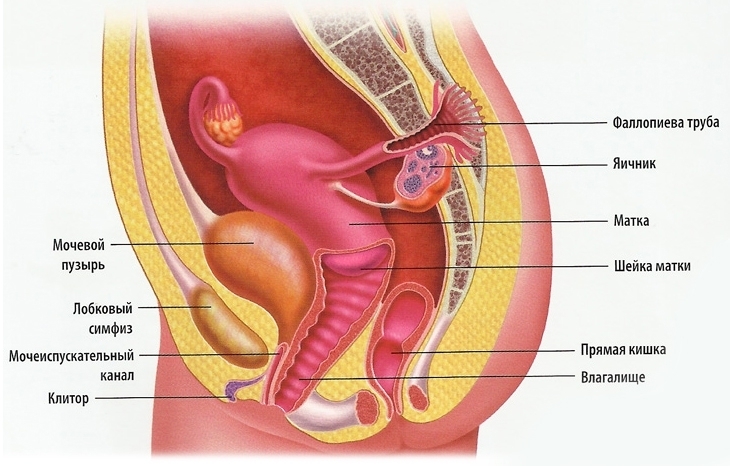 female pelvic organs( sexual) organs
female pelvic organs( sexual) organs - Vagina - hollow tubular organfrom the genital slit to the uterus. It has a length of about 10 centimeters and is adjacent to the cervix, the organ passes through the urinary-genital diaphragm
- . The uterus is an organ composed of muscles. It has the shape of a pear and is located behind the bladder, but in front of the rectum. The body is divided into: the bottom, the body and the neck. Performs the childbearing function
- Ovary - paired organ of ovoid form. This is a female gland that produces hormones. In them, the eggs are ripening. Ovary is connected to the uterus by fallopian tubes
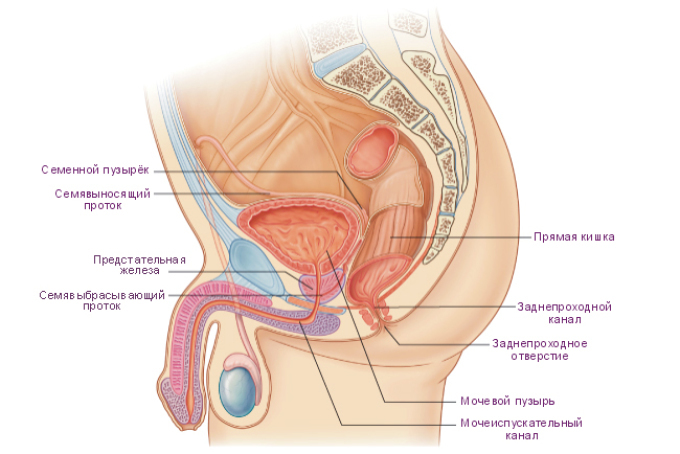 male pelvic organs( sexual) organs
male pelvic organs( sexual) organs - Seed vesicle - is located behind the bladder and has the appearance of a paired organ. This is the secretory male organ. Its size is approximately five centimeters in diameter. It is a mixture of bubbles connected to each other. Function of the organ - to produce a seed for fertilization
- The prostate gland is an organ consisting of muscles and glands. It is located directly on the urine-sexual diaphragm. The basis of the organ is the urinary and seminal canal
